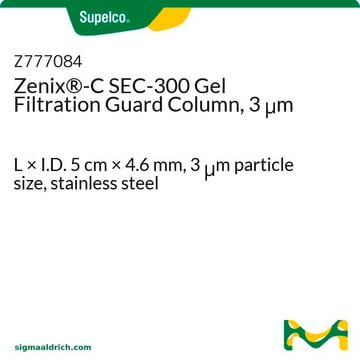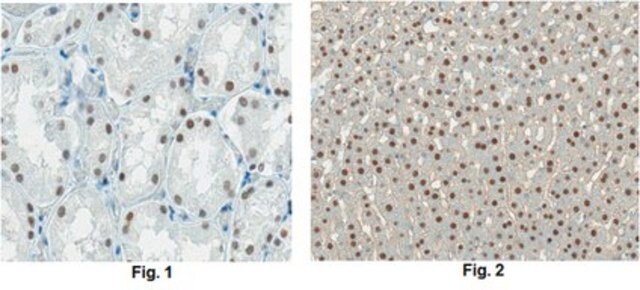Yes, it would be highly preferential (especially in this case where you want partitioning to dominate) to inject in high organic. That said, you can 'get away' with it if the injection volume can be kept small - much like we can inject low volumes of stronger solvents in RP mode, if needed. What you will want to do to minimize impact is to get as much retention on the analytes of interest as you can, this helps give the sample solvent some time to dissipate and negate the effects.
53938-U
Ascentis® Express 90 Å HILIC (2.7 μm) HPLC Columns
L × I.D. 7.5 cm × 2.1 mm, HPLC Column
Select a Size
$1,230.00
Estimated to ship on12 April 2025
Select a Size
About This Item
$1,230.00
Estimated to ship on12 April 2025
Recommended Products
Product Name
Ascentis® Express HILIC, 2.7 μm HPLC Column, 2.7 μm particle size, L × I.D. 7.5 cm × 2.1 mm
material
stainless steel column
Quality Level
Agency
suitable for USP L3
product line
Ascentis®
feature
endcapped: no
manufacturer/tradename
Ascentis®
packaging
1 ea of
parameter
≤100 °C temp. range
600 bar max. pressure (9000 psi)
technique(s)
HPLC: suitable
LC/MS: suitable
UHPLC-MS: suitable
UHPLC: suitable
L × I.D.
7.5 cm × 2.1 mm
surface area
135 m2/g
impurities
<5 ppm metals
matrix
Fused-Core particle platform
superficially porous particle
matrix active group
silica phase
particle size
2.7 μm
pore size
90 Å
operating pH
1-8
application(s)
food and beverages
separation technique
hydrophilic interaction (HILIC)
normal phase
Looking for similar products? Visit Product Comparison Guide
General description
Visit the Ascentis Express home page for more information on this new column technology.
Legal Information
guard cartridge
related product
required but not provided
Storage Class Code
11 - Combustible Solids
WGK
WGK 3
Flash Point(F)
Not applicable
Flash Point(C)
Not applicable
Choose from one of the most recent versions:
Certificates of Analysis (COA)
Don't see the Right Version?
If you require a particular version, you can look up a specific certificate by the Lot or Batch number.
Already Own This Product?
Find documentation for the products that you have recently purchased in the Document Library.
Articles
For separation of polar compounds including polar neutrals, polar acids, and polar and non-polar basic amines use our Ascentis® Express HILIC column.
Protocols
We offer the tools for the analysis of the metabolites; including certified reference standards, enzymes, substrates, and chromatographic products.
-
In HILIC separations, what happens if the sample is an aqueous matrix? Does it always have a negative effect?
1 answer-
Helpful?
-
-
Can peptide or protein samples be analyzed using HILIC columns?
1 answer-
Polar peptides are quite amenable to HILIC separations; however, our experience with larger peptides has been only minimally successful - mainly due to solubility issues. Proteins are even more difficult due to the same issue. An additional problem with proteins is that they are often multiply charged. When IEX is performed on multiply charged analytes, you often get what is referred to as a rolling effect where the analyte interacts with ionic sites on the surface in many different ways as it 'rolls' down the column; this produces broad and misshapen peaks.
Helpful?
-
-
What column do you recommend for an anionic compound?
1 answer-
If the acids are hydrophilic or you can adjust the pH to make them hydrophilic enough, any of the phases that exhibit HILIC partitioning are possible (bare silica, OH5, diol, Zwitterionic, amide). We typically go with the OH5 first to try and avoid any negative impacts on the like charge.
Helpful?
-
-
When referring to the pH of the mobile phase (pH 3, pH 4, etc.), does that refer to the aqueous part of the mobile phase?
1 answer-
Typically when we refer to pH in HILIC, we use the effective pH or the pH as measured after the addition of organic. The point is that we should always define what pH we are stating. The common way to distinguish is using notation of w/w pH or s/w pH (usually superscript/subscript). The notations mean superscript = solvent the pH is measured in (s would indicate some mixture of aqueous:organic) and the subscript = the solvent the pH meter is calibrated in (typically water (or w) as we readily have calibration standards).
Helpful?
-
-
Do I need special fittings and tubing to connect Ascentis® Express HPLC Columns?
1 answer-
While operating pressures may not exceed the 400 bar (6,000 psi) capability of your traditional instruments, sustained pressures of about 200 bar (3,000 psi) will exceed the recommended pressure for conventional PEEK tubing and fittings at the column inlet. We recommend changing to stainless steel fittings in all high pressure locations and have designed special High Performance HPLC Fittings/Interconnects that will stay tight at pressures of 1,000 bar (15,000 psi) or greater, even when elevated column temperatures are employed.
Helpful?
-
-
Can I use Ascentis Express on any type of HPLC system?
1 answer-
Ascentis Express HPLC columns are capable of use on standard HPLC systems as well as UHPLC systems. Columns are packed in high pressure hardware capable of withstanding the pressures used in UHPLC systems.
Helpful?
-
-
Would you advise addition of a buffer when using diol or amide stationary phase?
1 answer-
Yes. if possible you should always have at least a small amount of buffer in a HILIC system to help mediate/control IEX and other polar interactions that are bound to be present (even if at a low level). It is not so much the "buffering capacity" that is important, but the presence of the competing ions. We have found that their presence helps with day to day and column to column reproducibility. There are times when you need to eliminate the buffer, but aside from special circumstances, our recommendation is to include them.
Helpful?
-
-
What is the Department of Transportation shipping information for this product?
1 answer-
Transportation information can be found in Section 14 of the product's (M)SDS.To access the shipping information for this material, use the link on the product detail page for the product.
Helpful?
-
-
Is there anything special I need to do to my HPLC system to use Ascentis Express?
1 answer-
Nothing special is required to use Ascentis Express HPLC columns. To obtain the full benefits of Ascentis Express, one should minimize dispersion or instrument bandwidth in the HPLC system (tubing, detector flow cell) as well as confirm the detector response system is set at a fast level. For more information, request Guidelines for Optimizing Systems for Ascentis Express Columns (T407102)
Helpful?
-
-
What flow rate should I use with Ascentis® Express HPLC Columns?
1 answer-
Based on the minimum in the van Deemter curves, higher flows than 5um particle columns are required in order to maximize Ascentis Express column efficiency. The suggested starting point for flow rate for Ascentis Express columns: 1.6 mL/min for 4.6 mm ID; 0.8 mL/min for 3.0 mm ID; and 0.4mL/min for 2.1 mm ID.
Helpful?
-
Active Filters
Our team of scientists has experience in all areas of research including Life Science, Material Science, Chemical Synthesis, Chromatography, Analytical and many others.
Contact Technical Service







